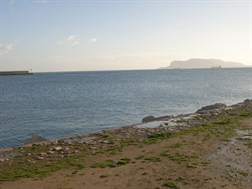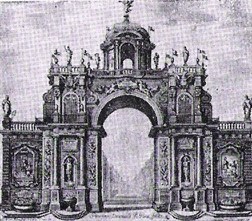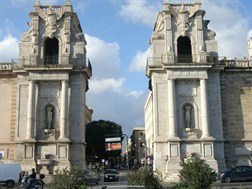The entry: Cassaro and Porta Felice
 The entry of the viceroy takes place from the sea. All the people gather on the pier where the main ship arrives. For the occasion a bridge is constructed connecting the mainland to the ship. The main urban magistracies and the Sicilian nobility congregate on the bridge. Our viceroy happily descended from the ship and the city offers itself to him in all its glory. To reach the cathedral, where the ceremony of possession will take place, he has to go through the entire city. The path is made easier by the fact that, during the sixteenth century, there was a long straight street: the CassaroThe road is the result of decades of hard work. It began on the opposite side of the city, where there are the Royal Palace and the Cathedral, in 1567. The work continued in stages, with a certain slowness, because it was to demolish most of the buildings that are located on the street towards the port. All was concluded only in the early eighties of the sixteenth century..
The entry of the viceroy takes place from the sea. All the people gather on the pier where the main ship arrives. For the occasion a bridge is constructed connecting the mainland to the ship. The main urban magistracies and the Sicilian nobility congregate on the bridge. Our viceroy happily descended from the ship and the city offers itself to him in all its glory. To reach the cathedral, where the ceremony of possession will take place, he has to go through the entire city. The path is made easier by the fact that, during the sixteenth century, there was a long straight street: the CassaroThe road is the result of decades of hard work. It began on the opposite side of the city, where there are the Royal Palace and the Cathedral, in 1567. The work continued in stages, with a certain slowness, because it was to demolish most of the buildings that are located on the street towards the port. All was concluded only in the early eighties of the sixteenth century..
 At the entrance of the road a superb triumphal arch greets the viceroy: it is an example of ephemeral architecture, commissioned by the Senate of Palermo, the highest municipal authority, to local poets and writers. The construction of the arch, work of decorators, carpenters, painters, upholsterers, was sponsored by the town. There are entire artisan families, such as the Amatos or the Palmas, specializing in the production of ceremonial artifacts. The decorative structure features musicians and actors, who recite verses composed for the occasion. It does not consist in the simple reiteration of laudatory epithets for the newcomer. Despite the distance, in Palermo people are fully familiar with the political equilibrium in Madrid, the pressures under which the viceroy was selected are known, the people thanks to whom he received his title and power are known and how he went about obtaining it. The texts that are recited, therefore, easily reveal the political expectations of the Sicilians, their fears and their “warnings”. These texts, generally printed and which constitute a real literary genre, are still available for the few curious readers in libraries in Sicily.
At the entrance of the road a superb triumphal arch greets the viceroy: it is an example of ephemeral architecture, commissioned by the Senate of Palermo, the highest municipal authority, to local poets and writers. The construction of the arch, work of decorators, carpenters, painters, upholsterers, was sponsored by the town. There are entire artisan families, such as the Amatos or the Palmas, specializing in the production of ceremonial artifacts. The decorative structure features musicians and actors, who recite verses composed for the occasion. It does not consist in the simple reiteration of laudatory epithets for the newcomer. Despite the distance, in Palermo people are fully familiar with the political equilibrium in Madrid, the pressures under which the viceroy was selected are known, the people thanks to whom he received his title and power are known and how he went about obtaining it. The texts that are recited, therefore, easily reveal the political expectations of the Sicilians, their fears and their “warnings”. These texts, generally printed and which constitute a real literary genre, are still available for the few curious readers in libraries in Sicily.
 The most visible legacy of these complex urban installations can still be seen at the end of Via Vittorio Emanuele – the new name of the Cassaro – the Porta Felice (Figure 3). The name is the result of a coincidence: Felice, Felice Orsini, was the name of the wife of the viceroy Marco Antonio Colonna, who commissioned the door in the eighties of the sixteenth century, “happy” is the epithet with which the city of Palermo is generally identified. For a long time the only part of the door which was built was the base. It lends itself magnificently to support complex ephemeral architectures designed for public ceremonies. Only in the early seventeenth century would work begin a new under the direction of Mariano SmiriglioArchitecht, painter and decorator from Palermo, Mariano Smiriglio (1561-1636) was one of the main protagonists of Sicilian art during the first half of the XVII century. and it was concluded in 1637.
The most visible legacy of these complex urban installations can still be seen at the end of Via Vittorio Emanuele – the new name of the Cassaro – the Porta Felice (Figure 3). The name is the result of a coincidence: Felice, Felice Orsini, was the name of the wife of the viceroy Marco Antonio Colonna, who commissioned the door in the eighties of the sixteenth century, “happy” is the epithet with which the city of Palermo is generally identified. For a long time the only part of the door which was built was the base. It lends itself magnificently to support complex ephemeral architectures designed for public ceremonies. Only in the early seventeenth century would work begin a new under the direction of Mariano SmiriglioArchitecht, painter and decorator from Palermo, Mariano Smiriglio (1561-1636) was one of the main protagonists of Sicilian art during the first half of the XVII century. and it was concluded in 1637.
Crossing the threshhold, there is a straight line that the viceroy must follow. At the end of the etching one can see Porta Nuova.
